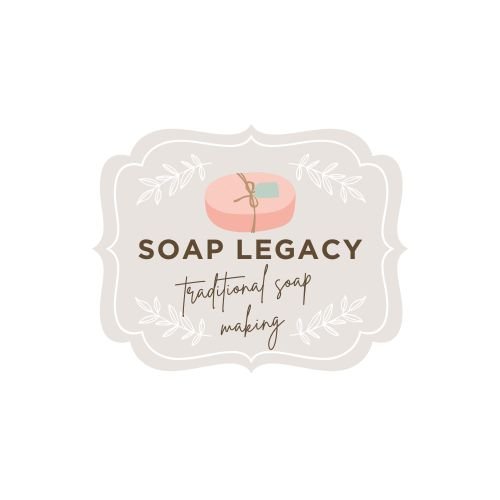To preserve soap using vitamin E, add 1-3% of total oils in cold process recipes or 1 teaspoon per pound for melt and pour. Mix at trace or with main oils. Vitamin E prevents rancidity but doesn't stop microbial growth. Store your vitamin-enhanced soaps in cool, dry places away from sunlight and use airtight containers. You can boost preservation by combining with other antioxidants like rosemary oleoresin extract. Discover how these techniques can triple your soap's shelf life.
Understanding Vitamin E as a Natural Soap Preservative

While many soapmakers focus on fragrance and appearance, understanding how to properly preserve your creations is equally essential for long-term success.
Vitamin E oil works as a natural antioxidant in your soap formulations, helping prevent rancidity in fixed oils that might otherwise turn your beautiful bars rancid prematurely.
For maximum effectiveness, you'll want to add Vitamin E at a usage rate of 1-3% in cold process recipes. This small addition considerably extends the shelf life of your soaps, particularly those containing oils prone to oxidation.
Remember that Vitamin E doesn't prevent microbial growth—it specifically combats oxidative stress that degrades oils. Many vegetable oils already contain natural tocopherols, but supplementing with additional Vitamin E provides extra insurance against premature spoilage without compromising your soap's natural qualities.
The Science Behind Oxidation in Handmade Soaps

In handmade soap making, free radical chain reactions trigger oxidation processes that transform your beautiful bars into rancid, discolored products with unpleasant odors.
Your soap's antioxidant defense system, naturally present in certain oils or added through vitamin E, works by intercepting these destructive free radicals before they can propagate the chain reaction.
You'll know oxidation is occurring by measuring rancidity levels through visual inspection for Dreaded Orange Spots (DOS), detecting off-putting smells, or using specialized testing methods that quantify peroxide values in your soap formulations.
Free Radical Chain Reactions
Understanding how free radical chain reactions affect your handmade soaps can help you preserve them effectively. These reactions occur when unstable free radicals attack your soap's molecules, triggering oxidation that breaks down fatty acids.
Once started, this chain reaction continues progressively, causing rancidity, unpleasant odors, and color changes in your products.
Vitamin E oil is your best defense against this destructive process. As a powerful antioxidant, it neutralizes free radicals before they can damage your soap's ingredients. By donating electrons to these unstable molecules, Vitamin E stops the chain reaction at its source.
You'll extend the shelf life of your handmade soaps considerably by incorporating Vitamin E oil into your formulations, especially when working with unsaturated fats that are particularly vulnerable to oxidation.
Antioxidant Defense System
The science behind soap oxidation reveals a fascinating battle at the molecular level. Your handmade soaps are constantly fighting against free radicals that cause rancidity and DOS. This is where Vitamin E oil works as a powerful ally in your antioxidant defense system.
To effectively prevent rancidity and extend the shelf life of your soaps:
- Add mixed tocopherols (Vitamin E) at less than 1% concentration to neutralize free radicals without destabilizing your formula.
- Incorporate high-Vitamin E oils like sunflower and avocado oil for dual benefits of antioxidant protection and conditioning properties.
- Apply Vitamin E at the right stage of production to maximize its effectiveness against oxidation.
Understanding this molecular shield helps you create soaps that maintain their quality, fragrance, and appearance considerably longer than unprotected formulations.
Measuring Rancidity Levels
When your handmade soap begins deteriorating, you're witnessing oxidation in action—a measurable chemical process rather than a mystery. You can quantify this deterioration by testing the peroxide value, which reveals how far oxidation has progressed in your soap's oils.
Watch for telltale signs: unusual odors, discoloration, or separation within your bars. These visual and sensory cues signal increasing rancidity levels that will impact your soap's quality and usability.
Before starting soap-making, test your oil batches to ascertain you're not incorporating already-spoiled ingredients. Adding antioxidants like Vitamin E oil creates a defensive barrier against free radicals, greatly extending your product's shelf life.
This preventative approach is more effective than trying to salvage already-oxidized soap, giving your creations lasting freshness and stability.
Optimal Dosage: How Much Vitamin E to Add

When adding Vitamin E oil to preserve your handcrafted soap, remember that a little goes a long way—typically 1-3% of your total oils for cold process or 1 teaspoon per pound of melt and pour base.
You'll want to incorporate it either at trace or directly with your main oils to guarantee even distribution throughout your batch.
Using the correct amount is critical, as excessive Vitamin E can actually accelerate oxidation and lead to those dreaded orange spots, while the ideal dosage will effectively slow rancidity and extend your soap's shelf life.
Measuring for Longevity
Because preserving your handmade soap requires precision, understanding the correct amount of Vitamin E to add is essential for excellent results.
When measuring Vitamin E to extend shelf life in your soap recipes, you'll need to balance effectiveness with potential side effects.
For best preservation and to prevent rancidity in your oils in soap, follow these guidelines:
- Cold process soap: Use between 1-3% of your total oil weight
- Melt and pour soap: Add approximately 1 teaspoon per pound of base
- General formulations: Keep dosage below 1% to avoid DOS (Dreaded Orange Spots)
Remember to test small batches first when incorporating Vitamin E.
While mixed tocopherols provide the best oxidation prevention, even small amounts contribute to your soap's longevity, though benefits may be subtle at lower concentrations.
Oil-to-Vitamin Ratios
Precise oil-to-vitamin ratios make all the difference between well-preserved soap and formulations prone to premature spoilage.
For cold process soap, add Vitamin E oil at 1-3% of your total oil weight to effectively extend the life of your bars. If you're working with melt and pour, use approximately 1 teaspoon per pound of soap base for best results.
Despite its preservation benefits, less is more with Vitamin E. Exceeding 1% can ironically accelerate rancidity and lead to dreaded orange spots (DOS).
Consider your base oils' fatty acid profiles when calculating your ratios—some oils naturally require more protection than others.
For maximum shelf life benefits, remember that mixed tocopherols work best, but even these should stay below the 1% threshold to protect your soap without compromising quality.
Different Forms of Vitamin E for Soap Preservation

Although many soapmakers recognize Vitamin E as a preservative, not all forms deliver the same benefits. When selecting Vitamin E oil to extend shelf life and prevent rancidity, you'll want to understand the options available for your cold process soap creations.
Mixed tocopherols offer the most effective antioxidant properties for soap preservation:
- Pure Vitamin E oil – Use at 1-3% of your formulation to combat oxidation without increasing DOS (dreaded orange spots).
- Natural oil-based sources – High oleic sunflower and avocado oils provide built-in Vitamin E with added moisturizing benefits.
- Rosemary Oleoresin Extract (ROE) – A powerful alternative that offers similar preservative qualities without the sticky texture of Vitamin E.
Remember that moderation is key—excessive amounts can actually accelerate oxidation rather than prevent it.
Combining Vitamin E With Other Natural Preservatives

While Vitamin E offers strong preservative qualities on its own, you'll achieve even greater protection for your soaps by pairing it with complementary natural preservatives.
Rosemary extract stands out as an excellent partner, working synergistically with Vitamin E to prevent oxidation and extend shelf life considerably.
For best results, incorporate Vitamin E oil at 1-3% of your formulation, while adding rosemary extract at 0.5-1%.
This powerful combination not only prevents the dreaded orange spots (DOS) that indicate rancidity but also enhances your soap's skin-nourishing properties.
This preservation strategy satisfies the growing demand for natural skincare products without compromising effectiveness.
Extending Shelf Life: Storage Tips for Vitamin-Preserved Soaps
Even the best vitamin-preserved soaps require proper storage to maximize their longevity. While Vitamin E works diligently to prevent oxidation, your storage practices considerably impact overall shelf life.
Store your soaps in cool, dry locations away from direct sunlight, and consider using airtight containers or wax paper wrapping to minimize air exposure.
High moisture environments like bathrooms can compromise your soap's integrity despite Vitamin E's preservative qualities. Regularly check stored soaps for discoloration or unusual odors that might indicate quality degradation.
For ideal preservation results:
- Combine Vitamin E with complementary preservatives like rosemary extract
- Use moisture-wicking materials when storing multiple soaps together
- Rotate your soap inventory to guarantee older products get used before newer ones
Recognizing and Preventing Rancidity in Soap
How quickly can your carefully crafted soap turn from a luxurious cleansing bar to a foul-smelling disappointment? Rancidity occurs when fatty acids oxidize, creating unpleasant odors and potential skin irritation.
You'll recognize rancidity by its distinctive musty smell, orange spots, or an unusual oily feel. To prevent this, incorporate Vitamin E oil at 1-3% of your formulation. This powerful antioxidant neutralizes free radicals that trigger oxidation while enhancing moisture retention in your bars.
Don't overdo it—excessive amounts of Vitamin E can actually accelerate oxidation. Consider using oils naturally high in Vitamin E, like avocado or sunflower, as part of your base recipe.
These extra ingredients not only help prevent mold but also contribute to a more stable, longer-lasting product without compromising quality or performance.
Frequently Asked Questions
How Much Vitamin E to Put in Soap?
You'll need 1-3% of Vitamin E oil based on total oil weight for cold process soap. For melt and pour, use 1 teaspoon per pound of soap base. Don't overdo it to avoid DOS.
How to Add Vitamin C to Soap?
To add vitamin C to soap, dissolve 0.5-2% sodium ascorbyl phosphate into your lye solution. You'll get better stability than with pure ascorbic acid. Store your finished soap in a cool, dark place.
How to Use Vitamin E in Soap Making?
Add vitamin E to your soap at 1-3% of your total oil weight either with base oils or at trace. You'll need about 1 teaspoon per pound of oils to prevent rancidity.
How Can I Make My Soap Last Longer?
To make your soap last longer, you'll need to add 1-3% Vitamin E oil to prevent rancidity, use high oleic oils, store in cool dry places, and formulate with balanced fatty acid profiles.
In Summary
You've now discovered how vitamin E can transform your soap-making routine. By adding this powerful antioxidant at the right dosage and combining it with other natural preservatives, you'll greatly extend your soap's shelf life. Remember to store your creations properly and watch for signs of rancidity. With these vitamin E preservation techniques, you're well-equipped to create longer-lasting, natural soaps your skin will thank you for.





Leave a Reply